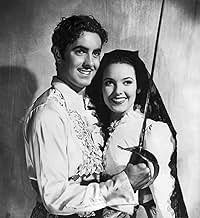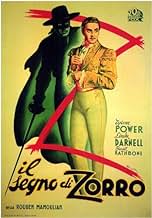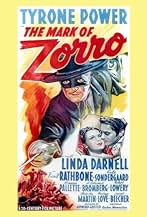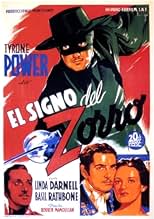IMDb RATING
7.5/10
12K
YOUR RATING
A young Spanish aristocrat must masquerade as a fop in order to maintain his secret identity of Zorro as he restores justice to early California.A young Spanish aristocrat must masquerade as a fop in order to maintain his secret identity of Zorro as he restores justice to early California.A young Spanish aristocrat must masquerade as a fop in order to maintain his secret identity of Zorro as he restores justice to early California.
- Nominated for 1 Oscar
- 4 wins & 1 nomination total
Ed Agresti
- Caballero
- (uncredited)
Featured reviews
This is what I can't help but like about the old high seas adventures and swashbuckling romances of the 1930s and '40s. You know, the ones where you can always hear Alfred Newman's bombastic score. The Mask of Zorro opens with a title card saying, "Madrid - when the Spanish Empire encompassed the globe, and young blades were taught the fine and fashionable art of killing
" So what's that, like 18...30? 1840? I guess we'll figure it out. And so we do, of course. But there was an unabashed syrupy-ness about the melodramatic urgency given to these movies.
When Zorro's not prancing around in his little cape eye-mask, he's playing the part of the utterly timid, and more than a touch effeminate, Don Diego Vega. The likelihood that Vega could be the remarkably expert swashbuckler never once dawns on the baddies, largely because Vega is such a stern little prude.
The first big-budget talkie starring the swashbuckling samaritan, Rouben Mamoulian's old-fashioned jaunt was a blockbuster in 1940, and it remains recalled quite warmheartedly by the Silent Generation's moviegoers, and equally the small screen's fascinated beginners among the Baby Boom, as one of the period's very best adventure pictures. One grows accustomed to the movie's qualitative foothold in that time of matinée idols and sword-fighting silver-screen hero worship, and we can concede for that reason. But tolerant filmgoers will stay open for a movie that's considerably chock-a-block with romance, action, duplicity, and courageous bravado, all in an overstated manner that could've only been taken seriously in 1940, and perhaps not one year later.
The nuts and bolts are all here: Don Diego is invited to come home from Madrid to his family in Los Angeles, but upon his reappearance he learns that his father's standing as "alcalde" has been seized by the shameless Don Luis Quintero, a nasty piece of work who's nothing more than a minion to the man enjoying the real supremacy: Captain Esteban Pasquale. As expected, Diego/Zorro means to linger in Los Angeles just long enough to depose the scoundrels, entice a pretty slice of illicit fruit, and bring integrity to his family's native soil. Nothing ground-breaking here, but there's nothing amiss in a straightforward adventure yarn told in the traditional way.
When Zorro's not prancing around in his little cape eye-mask, he's playing the part of the utterly timid, and more than a touch effeminate, Don Diego Vega. The likelihood that Vega could be the remarkably expert swashbuckler never once dawns on the baddies, largely because Vega is such a stern little prude.
The first big-budget talkie starring the swashbuckling samaritan, Rouben Mamoulian's old-fashioned jaunt was a blockbuster in 1940, and it remains recalled quite warmheartedly by the Silent Generation's moviegoers, and equally the small screen's fascinated beginners among the Baby Boom, as one of the period's very best adventure pictures. One grows accustomed to the movie's qualitative foothold in that time of matinée idols and sword-fighting silver-screen hero worship, and we can concede for that reason. But tolerant filmgoers will stay open for a movie that's considerably chock-a-block with romance, action, duplicity, and courageous bravado, all in an overstated manner that could've only been taken seriously in 1940, and perhaps not one year later.
The nuts and bolts are all here: Don Diego is invited to come home from Madrid to his family in Los Angeles, but upon his reappearance he learns that his father's standing as "alcalde" has been seized by the shameless Don Luis Quintero, a nasty piece of work who's nothing more than a minion to the man enjoying the real supremacy: Captain Esteban Pasquale. As expected, Diego/Zorro means to linger in Los Angeles just long enough to depose the scoundrels, entice a pretty slice of illicit fruit, and bring integrity to his family's native soil. Nothing ground-breaking here, but there's nothing amiss in a straightforward adventure yarn told in the traditional way.
The only ingredient missing here is a Fox budget that would have provided Technicolor photography as a part of the film's lush production values. However, even without three-strip Technicolor, this B&W version of the famous legendary outlaw is acted to perfection by the entire cast.
Tyrone Power goes with great ease from the fop to the swashbuckler Zorro, all the while displaying a great deal of charm and good looks. The romantic role of "the girl" goes to Linda Darnell who is more than adequate in the looks department herself.
In the chapel scene and "The White Sombrero" dance routine they have a chance to show the kind of sparks that made them popular movie stars of the '40s. Linda was just about to break out of her virginal roles and about to play more tempestuous heroines, but she does an excellent job as Power's love interest.
Basil Rathbone is at his finest for the final dueling scene, surely even more robustly performed than the one he shared with Errol Flynn in THE ADVENTURES OF ROBIN HOOD--and that's really saying something. Power seems to be evenly matched with Rathbone in his skilled swordsmanship.
Alfred Newman's fitting pseudo-Spanish background music provides just the right amount of excitement to make this a most entertaining show. And the supporting cast--including Gale Sondergaard, J. Edgar Bromberg, Eugene Palette, Montagu Love, Janet Beecher and others is excellent.
By all means worth watching anytime for sheer entertainment.
Tyrone Power goes with great ease from the fop to the swashbuckler Zorro, all the while displaying a great deal of charm and good looks. The romantic role of "the girl" goes to Linda Darnell who is more than adequate in the looks department herself.
In the chapel scene and "The White Sombrero" dance routine they have a chance to show the kind of sparks that made them popular movie stars of the '40s. Linda was just about to break out of her virginal roles and about to play more tempestuous heroines, but she does an excellent job as Power's love interest.
Basil Rathbone is at his finest for the final dueling scene, surely even more robustly performed than the one he shared with Errol Flynn in THE ADVENTURES OF ROBIN HOOD--and that's really saying something. Power seems to be evenly matched with Rathbone in his skilled swordsmanship.
Alfred Newman's fitting pseudo-Spanish background music provides just the right amount of excitement to make this a most entertaining show. And the supporting cast--including Gale Sondergaard, J. Edgar Bromberg, Eugene Palette, Montagu Love, Janet Beecher and others is excellent.
By all means worth watching anytime for sheer entertainment.
What fun! This film has not aged a day in 63 years.....it is still a great tale of old California and the masked caballero, Zorro. Tyrone Power plays it to the hilt, and is especially good in his alter ego of the effeminate fop, Don Diego. He may not be quite as acrobatic as Fairbanks was in the original silent version but it doesn't detract from the performance. And Power was a fencer, so his sword fighting scenes certainly rang true. Put him with that elegant gentleman, Basil Rathbone, also an excellent swordsman, and you get one of the best sword fights in film history. Rathbone is the other shining star of this film. He oozes evil and was the master of the condescending sneer. The supporting cast is impeccable.....Palette, Sondergaard, Bromberg, Love, and the young, extremely beautiful Linda Darnell. It is curious to note that both Gale Sondergaard and J. Edward Bromberg were caught up in the Red Scare in Hollywood in the late 40'3, early 50's and their careers were basically destroyed by it.
This is a rousing, fun film with great dialogue and should be on everyone's "must see" list. One curious thing.......how did those very revealing tight pants worn by Power and Rathbone get by the Hays Office? These were the days when you could not even show a married couple sharing the same bed and those pants didn't leave much to the imagination!
This is a rousing, fun film with great dialogue and should be on everyone's "must see" list. One curious thing.......how did those very revealing tight pants worn by Power and Rathbone get by the Hays Office? These were the days when you could not even show a married couple sharing the same bed and those pants didn't leave much to the imagination!
This movie was directed by Rouben Mamoulian and this was basically the only action movie he directed and probably his best film, he made one more movie with Tyrone Power a year later called Blood And Sand and that was pretty bad. This is also one of Power's best movies and much better than Jesse James the year before. Their isn't much to the plot that you need to know like Power coming back from Spain and finding his father thrown out of power by a dictator and the people are starving. His father can't or won't do anything so Power decides to become Zorro. Basil Rathbone is the dictator's top bodyguard and a top swordsman. Linda Darnell is the dictator's daughter who winds up getting married to Power through an arranged marriage. This is much better then the remake in 98 called The Mask Of Zorro and a great movie.
One thing this movie has is impressive horse riding chase scenes that make you grin at the ingenuity of the director and the cinematographer. The films pace is so exciting that you know that you just have to dip your hat to how it was captured on celluloid. Basil Rathbone (who is famous for playing Sherlock Holmes in the Rathbone/Bruce series that contained 14 movies between the years of 1939 – 1946) is a famous Hollywood swordsman, and I also read that Tyrone Power was also good with sword, and so I eagerly waited for the duel scene between the two.
When the duel started, the idea that this was actually both the actors willing the swords and not just mere stunt men also added to the fun, as the duel is just wonderful and masterful, the grace and the speed the two masterful swordsmen displayed on screen is one that I will always remember, and one that I ask others to see, because I have not seen better fencing than that as of now.
The movie had scenes that jumped at you, there was another chase scene where Zorro (Tyrone Power) made his horse jump off a bridge into a stream and made the horse ride/swam to shore, it was such a sight I raised my brow in amazement, wondering how many shots the director had to take to get that scene right.
The Mark of Zorro is fun, although you can pick out plot holes and wonder how the hero was planning to achieve anything in the riot like ending, but the movie was fun to see all the way through, the story arc is taken from the story The Curse of Capistrano written by Johnston McCulley in 1919, the book introduced the masked hero Zorro, who was like Robin Hood in most sense. Set in Southern California during the early 19th century, the plot deals with Don Diego Vega/Zorro (Tyrone Power), who returned home to find that his town is being extorted by the Governor and his henchman Captain Esteban Pasquale (Basil Rathbone).
Diego then became the mask vigilante Zorro to be able to able to defend his people from the hand of the corrupt Governor.
The Mark of Zorro is a true oldie; the score is so obvious and doesn't blend with the movie (from my own point of view) although the score did get an Academy Award nomination.
The Mark of Zorro is one you can take the time to see even if it is just to see the duel between Power and Rathbone.
www.lagsreviews.com
When the duel started, the idea that this was actually both the actors willing the swords and not just mere stunt men also added to the fun, as the duel is just wonderful and masterful, the grace and the speed the two masterful swordsmen displayed on screen is one that I will always remember, and one that I ask others to see, because I have not seen better fencing than that as of now.
The movie had scenes that jumped at you, there was another chase scene where Zorro (Tyrone Power) made his horse jump off a bridge into a stream and made the horse ride/swam to shore, it was such a sight I raised my brow in amazement, wondering how many shots the director had to take to get that scene right.
The Mark of Zorro is fun, although you can pick out plot holes and wonder how the hero was planning to achieve anything in the riot like ending, but the movie was fun to see all the way through, the story arc is taken from the story The Curse of Capistrano written by Johnston McCulley in 1919, the book introduced the masked hero Zorro, who was like Robin Hood in most sense. Set in Southern California during the early 19th century, the plot deals with Don Diego Vega/Zorro (Tyrone Power), who returned home to find that his town is being extorted by the Governor and his henchman Captain Esteban Pasquale (Basil Rathbone).
Diego then became the mask vigilante Zorro to be able to able to defend his people from the hand of the corrupt Governor.
The Mark of Zorro is a true oldie; the score is so obvious and doesn't blend with the movie (from my own point of view) although the score did get an Academy Award nomination.
The Mark of Zorro is one you can take the time to see even if it is just to see the duel between Power and Rathbone.
www.lagsreviews.com
Did you know
- TriviaThe famous duel was staged by Hollywood fencing master Fred Cavens. He specialized in staging duels that relied more on real swordplay rather than the jumping on furniture and leaping from balconies that many film duels incorporated up until that point. Cavens' son, Albert Cavens, doubled for Tyrone Power in the fancier parts of the duel (mostly with his back to camera), such as the extended exchange with Esteban ending with Don Diego's sword smashing into the bookcase. Basil Rathbone, a champion fencer in real life, did not care for the saber (the weapon of choice in this film), but nevertheless did all of his own fencing. Fast fencing shots were under-cranked to 18 or 20 frames per second (as opposed to the standard 24fps) and all the sound effects were post-synchronized.
- GoofsThe character "Captain Esteban Pasquale" uses the Italian spelling for his surname. The Spanish spelling is Pascual. While a subsequent addition to this entry has sought to attribute it to the presence of Italian mercenaries in the Spanish army of the period, the inescapable fact is that the screenwriter had more important things to attend to than inject such a trivial historical footnote. He misspelled Pascual's name in the script (made obvious by Basil Rathbone's pronouncing it in the two-syllable Spanish form, pas-KWAL), and that misspelling was then incorporated in the copy provided the department that drew up the film's end title.
- Quotes
Captain Esteban Pasquale: His Excellency will never forgive me if I let you go without a word of welcome from him. I'm quite sure that you'll save me a reprimand.
Don Diego Vega: How could I refuse a man anything with a naked sword in his hand?
- Crazy creditsOpening credits prologue: MADRID - when the Spanish Empire encompassed the globe, and young blades were taught the fine and fashionable art of killing ...
- Alternate versionsAlso available in a colorized version.
- ConnectionsEdited into Myra Breckinridge (1970)
Details
- Release date
- Country of origin
- Languages
- Also known as
- La marca del Zorro
- Filming locations
- Production company
- See more company credits at IMDbPro
Box office
- Budget
- $1,000,000 (estimated)
- Gross worldwide
- $10,248
- Runtime1 hour 34 minutes
- Color
- Aspect ratio
- 1.37 : 1
Contribute to this page
Suggest an edit or add missing content





































